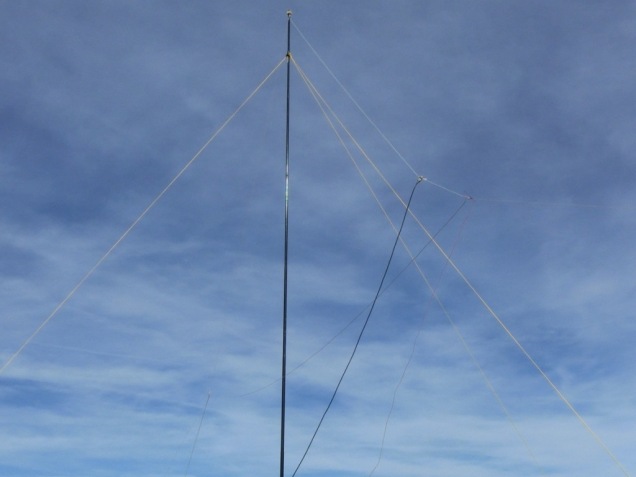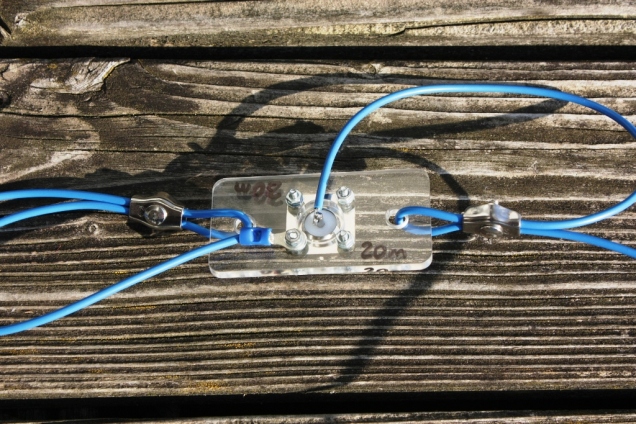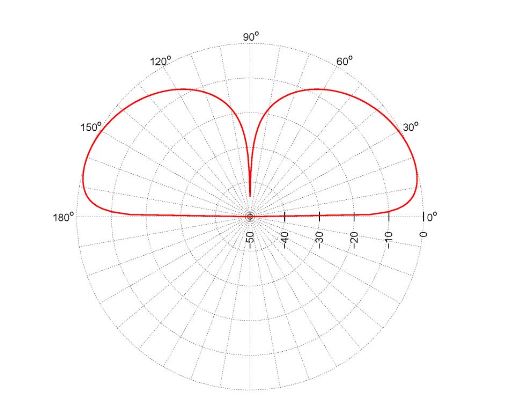A delta loop antenna is not particularly suitable for SOTA. It requires much more space than a vertical and the set-up is more complex.
Nevertheless I’d like to show this design here because sometimes space (and weight) don’t matter and a low take off angle is welcome.
If you are looking for a delta loop for the 40 metre band, try this Link.
A possible application could be the VK/ZL/JA <> EU S2S event or the Trans- Atlantic S2S QSO party.
During our DX-pedition (Link) to the Principality of Liechtenstein in Sept. 2013. DL4AAE worked hundreds of JA’s on 20 metres with this antenna and 100 W output power.

Design:
Uwe, DL4AAE, ran various simulations in order to optimize the „classical“ delta loop design. He summarized the results in an excellent presentation here (German only). Based on his design I built the following delta loop:

Dimensions (optimized for 14.050 kHz):
h0 = 2,0 m
h = 4,0 m
a = 0.7 m
x = 4.88 m
U = 22.5 m (Umfang/circumference)
The circumference has been calculated for a wire with an inner diameter of approx. 1.6 mm (conductor) and an outer diameter of 3 mm (insulating material PVC).
Support:
The shown design requires a pole of just six metres height. A six- metre squid pole is not recommended however, because the top segment is way too thin. We use a ten metre pole from DX-wire instead. Not used segments can been removed to reduce weight.
The wire runs loosely through an insulator at the top. This allows the Delta Loop to be easily aligned symmetrically.
Feeding:

As shown in the picture above, this design can be fed with 50 Ohm coaxial cable and requires neither BALUN nor matching.
Make sure the coax runs perpendicular to the plane of the loop. It musn’t touch the antenna wire!
Details:


Performance:
The bandwidth of this design is huge. If tuned to 14.175 kHz, it will cover both, the CW- and SSB- portion of the 20 metre band.

The calculated gain is 3.5 dBi. Thanks to the mostly vertical polarisation, the vertical take off angle is only approx. 20° and doesn’t change much with ground properties.

The horizontal radiation pattern is nearly omnidirectional with its maximum perpendicular to the broad side of the loop.

Conclusion:
The new design of the delta loop has several advantages:
- impedance approx. 50 Ohms, thus no matching required
- feeding with coaxial cable is possible, no BALUN required
- large bandwidth
- low take- off angle
- ground properties have little impact on take- off angle
It could be worth trying on a summit…
All credits go to DL4AAE.
I like this a lot and will build one this weekend. Thanks for this design
I turned my 40m dipole into a diamond quad for 20m and tried it for a short period at the end of an activation. I think this design is very good and may try it for one of those s2s events. 73 Andrew VK1DA/VK2UH
Such a great solution to get rid of the weight issue of matching and BALUN hardware!
I built this one for 20m and put it to the test last evening (Wednesday, August 12th, 2020). Perfect match where I wanted it (middle of the band), quiet reception and… easy to work DX!
First shout with the deltaloop to an Atlantic Ocean /MM station west of Angola was immediately replied to. What followed was LU and PY and a Siberian station with pretty nice S reports. Putting it up and taking it down is a matter of minutes (plenty of space when I go /P, no space enough for deployment at home). Since it is also lightweight the Spiderbeam pole is more than happy to keep it all up in shape.
Thanks for the great feedback, Ramon! I’m glad the delta loop works as intended!
If located near salt water (that’s what I can see on many photos on your QRZ.com site) the delta loop has a really low take off angle. Good for DX.
Best 73,
Roman
It really does, Roman. And you may have guessed it already, I will take it to the island next year, for sure. Weather and time permitting I’ll be deploying it this weekend for further testing and getting to know it better.
And your wordpress blog was a great find! I already sent it to some amateurs yesterday.
73
Ramon
good luck then, Ramon! Please share your experience. We live too far away from the sea (~ 800 km) I don’t have many occasions to play with the loop near water.
73, Roman
I certainly will, Roman! FYI (and hopefully with your concurrence) I used the link to this page on my QRZ.COM page for PE75OUW. If not OK, please let me know.
73,
Ramon